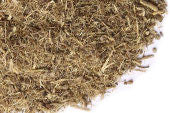Kudzu root cut & sifted
Kudzu root cut & sifted
Couldn't load pickup availability
Kudzu
Pueraria lobata
Kudzu is a climbing vine in the pea family that is originally native to most of Asia but is now firmly planted in the southeastern United States to the point of becoming a serious nuisance weed. In fact, its aggressive growing habit has earned it the nickname of “the vine that ate the south” and “mile-a-minute vine.” In Asia, however, kudzu is known as Japanese arrowroot and is welcome in the kitchen as a thickening agent for soups, stews and sauces. Because the starchy root of the plant is also a good source of fiber it is referred to as ko-hemp and is used in basketry and to produce cloth and other textiles. Dried kudzu root is used to make teas, infusions and tinctures.
While fresh kudzu root is cooked as a vegetable, the dried root is used to prepare teas, tinctures and tonics. Kudzu root, which has a high concentration of isoflavones, is also processed commercially as a dietary supplement.
"Kudzu is an herb used in Chinese medicine to treat alcoholism, heart disease, menopausal symptoms, diabetes, fever, the common cold, and neck or eye pain. It is sometimes used in combination with other herbs. Lab studies suggest that kudzu has anti-inflammatory and neuroprotective properties. Compounds called isoflavones are thought to be responsible for its potential effects." - Memorial Sloan Kettering Cancer Center
a bit of botany
a little botanical information on kudzu
description
Pueraria lobata, a member of the Fabaceae family, is a perennial climbing, coiling, and trailing vine growing to 10 m (32ft 10in) and at a fast rate. It has trifoliate leaves that have coarsely lobed leaflets and produces large, wisteria-like, purple flowers on long racemes, and beans in flat, papery pods covered with a tawny down.
Kudzu plants produce long lateral runners that generate roots at intervals. It is in flower from September to October. The flowers are hermaphrodite (have both male and female organs) and are pollinated by insects. This plant can fix nitrogen in the soil, thus improving the soil. Where it occurs as an invasive species, it is considered a noxious weed that climbs over trees or shrubs and grows so rapidly, it kills them by heavy shading.
common names & nomenclature
The common name kudzu comes from the Japanese name for the plant, kuzu, which in historical accounts was written "kudzu".
Also known as:
kudzu, gegen, “mile-a-minute-vine,” “foot-a-day-vine”, “the vine that ate the south”, japanese arrowroot
Share


